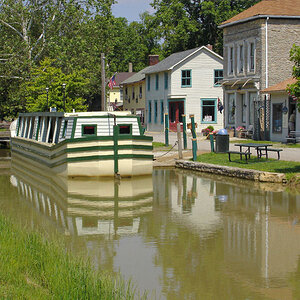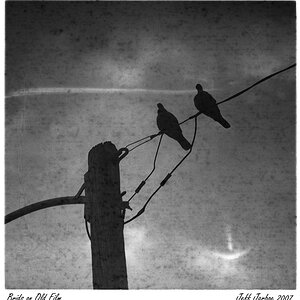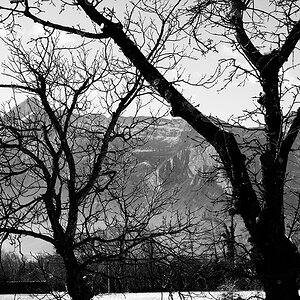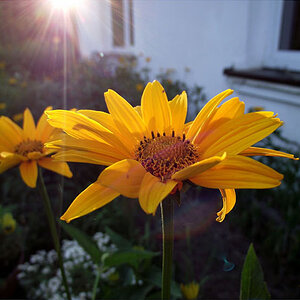- Joined
- Mar 8, 2011
- Messages
- 25,160
- Reaction score
- 9,010
- Location
- Iowa
- Website
- pixels.com
- Can others edit my Photos
- Photos NOT OK to edit
What this forum needs is a book review thread. No, not a, "Hey, this is a good book!' thread. An honest book review thread.
If you've got a book you've read and would like to post a review of it, by all means feel free to do so! I merely ask that it be a review of the tome, not a simple line or two. And if someone's already reviewed a book, that doesn't mean YOU can't..... your opinion is just as valid as someone else's!
So I'm going to kick it off with a review of Ansel Adams' The Camera, The Negative and The Print.
Admittedly, they were originally written back before digital came of age, and at first it may seem that they should be relegated to collecting dust in the libraries of film aficionados or stuffed away in a closet or attic. But if one takes the time to read them carefully and pay close attention, one can garner a lot of valuable information from these three books.
One of Adams' more noted quotes is, " The negative is the equivalent of the composer’s score, and the print the performance" And within the pages of these three books Adams manages to teach a lot about how to take the photographic equivalent of music from a concept to the concert hall.
It may take a while, but sooner or later, the reader eventually gets the idea that photography is an entire process..... from viewing and understanding the scene, to exposing the image, to developing the film. On through developing the film, quantifying the tonal values in the negative, understanding how various chemicals, times and temperatures affect the final outcome of the image. Even choosing between different papers and developers, all have a visible impact on the end result. And while aimed at shooting with film, the concept can be readily adapted to modern digital workflows.
While many of the images used in the book are not what I would consider his best, I have to stop and remind myself that the image was chosen to show the reader in a image(s) what is being discussed in the text. In fact, I only recognized two of his images in all three books.
In The Camera, the first of the three, the book is dedicated to the basic tools of the craft. Small, medium and format cameras are all discussed, as well as lenses, shutters, tripods, view camera movements, meters, filters et al. One nice feature of all the books is a small triangle placed in the text, to the left of which is a reference to a diagram or image, another page or a page in another book, which is to guide you such for a more in-depth explanation. The Camera should be part of every photographer's library, even if you borrow it long enough to read it. Many of the points discussed are applicable to both film and digital imaging.
Things tend to reflect a distinct 'analog' feel when one delves into The Negative, and little could be of use to anyone who shoots strictly digital. Various types of film and exposure techniques are proffered, as well as a seemingly endless array of developing processes. Yet the book does contain the best explanation of the Zone System I've ever encountered. So there is still much to be learned by the digital shooter in the book in terms of visualization, filters, and natural and artificial light.
In The Print, all of the readers' knowledge will be put to the test. Again, while aimed at printing in a darkroom with light-sensitive paper, a safelight, an enlarger and trays full of chemicals, the logical progression of thought still applies: Did your image come out as you had planned it to before you pressed the shutter button? And Adams doesn't stop after laying the print out to dry. He went to great pains to make sure the print was made in a manner best suited for where the image was to be displayed.
True, few of us will have the opportunity to show 40 or 50 of our best works in a top-end gallery, and there's a marked difference between a wet darkroom and Photoshop. But the concept is the same. Envision your final image while in the field. Use the tools you have to the fullest extent possible. Know how each piece of equipment you can bear will affect your images. Expose the image to take advantage of all your gear and knowledge. And perform whatever post work is needed to bring out the result you envisioned.
All three books have been through several printings, so there's more than one version out there. The ones I have are a matched set, and were all printed in 1994 (13th printing for The Camera, 14th for The Negative, and 12th for The Print). Most likely, any set or individual books you're likely to find for sale will be used, so don't be afraid to bide your time to get a set that's not worn out. Amazon.com and ebay.com are probably going to be your best bet. It's probably best to get a 'matched' set, if for no other reason to make sure the references between the books is consistent. Plus, it just looks better while displayed in your library!
If you've got a book you've read and would like to post a review of it, by all means feel free to do so! I merely ask that it be a review of the tome, not a simple line or two. And if someone's already reviewed a book, that doesn't mean YOU can't..... your opinion is just as valid as someone else's!
So I'm going to kick it off with a review of Ansel Adams' The Camera, The Negative and The Print.
Admittedly, they were originally written back before digital came of age, and at first it may seem that they should be relegated to collecting dust in the libraries of film aficionados or stuffed away in a closet or attic. But if one takes the time to read them carefully and pay close attention, one can garner a lot of valuable information from these three books.
One of Adams' more noted quotes is, " The negative is the equivalent of the composer’s score, and the print the performance" And within the pages of these three books Adams manages to teach a lot about how to take the photographic equivalent of music from a concept to the concert hall.
It may take a while, but sooner or later, the reader eventually gets the idea that photography is an entire process..... from viewing and understanding the scene, to exposing the image, to developing the film. On through developing the film, quantifying the tonal values in the negative, understanding how various chemicals, times and temperatures affect the final outcome of the image. Even choosing between different papers and developers, all have a visible impact on the end result. And while aimed at shooting with film, the concept can be readily adapted to modern digital workflows.
While many of the images used in the book are not what I would consider his best, I have to stop and remind myself that the image was chosen to show the reader in a image(s) what is being discussed in the text. In fact, I only recognized two of his images in all three books.
In The Camera, the first of the three, the book is dedicated to the basic tools of the craft. Small, medium and format cameras are all discussed, as well as lenses, shutters, tripods, view camera movements, meters, filters et al. One nice feature of all the books is a small triangle placed in the text, to the left of which is a reference to a diagram or image, another page or a page in another book, which is to guide you such for a more in-depth explanation. The Camera should be part of every photographer's library, even if you borrow it long enough to read it. Many of the points discussed are applicable to both film and digital imaging.
Things tend to reflect a distinct 'analog' feel when one delves into The Negative, and little could be of use to anyone who shoots strictly digital. Various types of film and exposure techniques are proffered, as well as a seemingly endless array of developing processes. Yet the book does contain the best explanation of the Zone System I've ever encountered. So there is still much to be learned by the digital shooter in the book in terms of visualization, filters, and natural and artificial light.
In The Print, all of the readers' knowledge will be put to the test. Again, while aimed at printing in a darkroom with light-sensitive paper, a safelight, an enlarger and trays full of chemicals, the logical progression of thought still applies: Did your image come out as you had planned it to before you pressed the shutter button? And Adams doesn't stop after laying the print out to dry. He went to great pains to make sure the print was made in a manner best suited for where the image was to be displayed.
True, few of us will have the opportunity to show 40 or 50 of our best works in a top-end gallery, and there's a marked difference between a wet darkroom and Photoshop. But the concept is the same. Envision your final image while in the field. Use the tools you have to the fullest extent possible. Know how each piece of equipment you can bear will affect your images. Expose the image to take advantage of all your gear and knowledge. And perform whatever post work is needed to bring out the result you envisioned.
All three books have been through several printings, so there's more than one version out there. The ones I have are a matched set, and were all printed in 1994 (13th printing for The Camera, 14th for The Negative, and 12th for The Print). Most likely, any set or individual books you're likely to find for sale will be used, so don't be afraid to bide your time to get a set that's not worn out. Amazon.com and ebay.com are probably going to be your best bet. It's probably best to get a 'matched' set, if for no other reason to make sure the references between the books is consistent. Plus, it just looks better while displayed in your library!






![[No title]](/data/xfmg/thumbnail/39/39183-f229dae0963376879140c9959e33f935.jpg?1619738903)
![[No title]](/data/xfmg/thumbnail/37/37604-7ad625e983f92f880eb65a264eeef5e4.jpg?1619738148)





